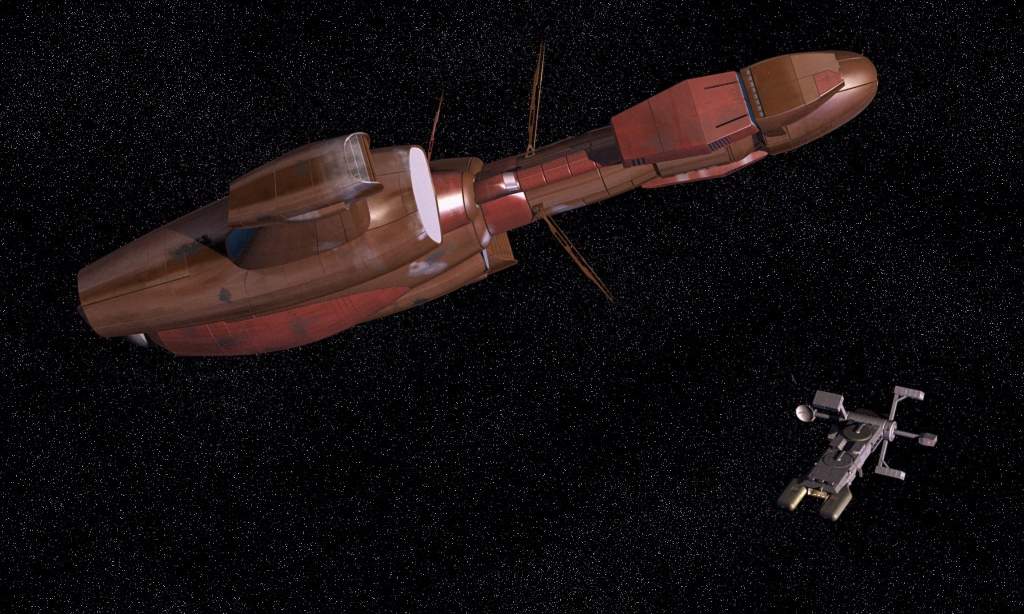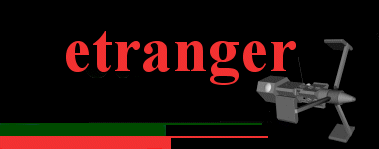
Ships of the Kafer War
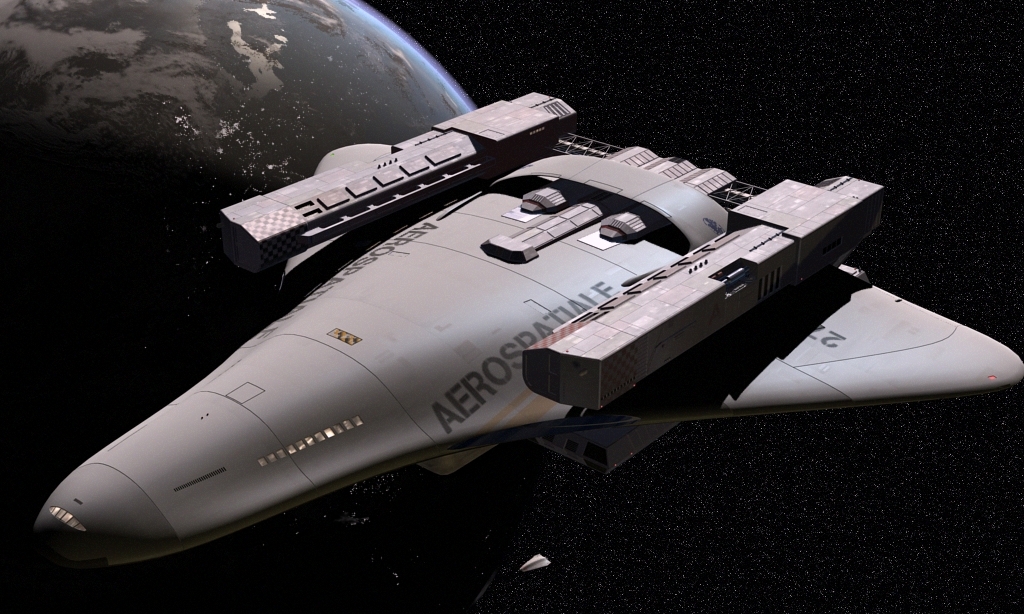
|
Above: The Bayeaux late in 2300 preparing to depart from Earth orbit on a scheduled trip to Beta Canum. The ship was taken up by Admiral Rochemont on arrival and supported his operations throughout the Invasion.
Introduction The
Kafer War has effectively militarised an entire arm of space and raised
tension through the worlds occupied by humanity. Against the Kafers
there is no such thing as a non-combatant, and civilian ships from every
nation have found themselves in the firing line. So while warships have
born the brunt of the fighting there are many other ships that have
made a major contribution to the conduct of the war.
Narrative The
Claude-Louis Berthollet nosed silently
into the orbit of another of the border system’s minor outer planets.
It was an iceball so insignificant it didn’t even rate a name, but these
were the worlds the Kafers liked best to hide in. After a number of
orbits on passive scan the captain told the crew to begin the active
scan. This
was the most dangerous part of the mission, if there was a concealed
Kafer base down there they often responded with a volley of ASAT missiles. The Claude-Louis Berthollet
was armoured and equipped with a self-defence armament but this was
limited and could be quickly overwhelmed. As a result the Berthollet
had its own goalkeeper the French frigate Aventurier.
Indeed the Berthollet was such an important
asset the fleet commanders feared a Kafer ambush and a full squadron
was in-system on the FTL shelf as an insurance policy. “Alarme!
Alarme!” The sensors picked up the first pulses of ground to orbit
targeting radars. Seconds later there was the flash of surface launched
Zulu missiles erupting from their hidden silos…
Cayuga |
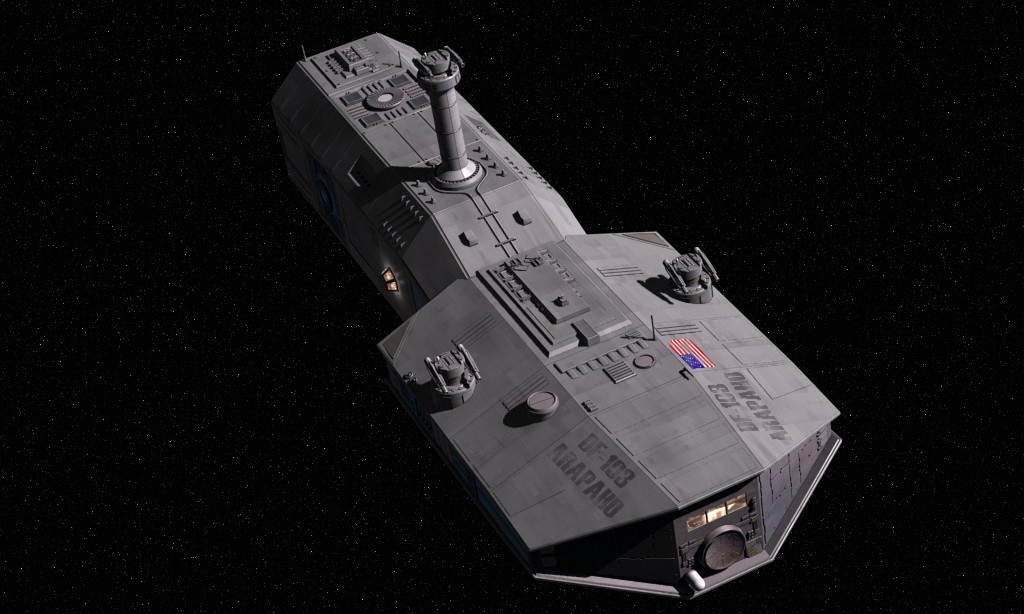
|
Above: The Arapaho in 2303 operating at the end of the American Arm in support of 'Backdoor' operations.
The
Cayuga is the United States Space Force’s current ‘Destroyer Escort’,
a ship designed for escort work along the American and lower Chinese
Arms. The Cayugas are regarded as something
of an unlucky class, having suffered from design problems, cost overruns
and combat losses. The Cayuga was a compromise right from the start,
suffering from a shortage of funds as the USSF
placed its budgetary surplus into the Kennedy,
indeed the Cayuga was based of a design from the 2220s. As a result
while the Cayuga had adequate armament, sensors and speed for its role
its suffered from a serious drive problem and had no spin habitat to
keep its crew in prime condition. The
drive problem was eventually solved after the first two ships were already
commissioned. This expensive redesign along with the limitations of
the design resulted in plans for building 13 ships of this class being
reduced by two to 11. The problem of crew degradation through over exposure
to Zero-G was solved by monthly crew rotations, something that was not
seen as a problem on the American Arm. The final three ships of the
class were built with expanded missile magazines for increased self
defensive capability. The
first real combat test for the two ships occurred in the Rho Eridani system above the world
of Heidelsheimat in 2298 while escorting a convoy of American ships
bringing goods to the secessionist Bavarian colony there. The Apache
and Cayuga found themselves caught between local Bavarian Raumwaffe and the blockading German DSKM
squadron who believed the American transports were carrying a consignment
of weaponry. In the ensuing fight the Apache was badly hit and
eventually abandoned following the failure of the damage control teams
to defeat internal fires. In
the same year the Pueblo was assigned to the aid of the Tanstaafl
colony on Aurore as rumours of a hostile alien presence became known,
protecting shipping moving between Eta Bootis and Hochbaden. The Pueblo
was destroyed in the initial Kafer incursion and the outrage in
America laid the way for the dispatch of a more capable USSF
squadron to the frontiers of the French Arm. However the loss of two
Cayugas in a year brought home the ship’s
limitations to the USSF and the ship was firmly
assigned to rear echelon duties, predominantly in the American Arm.
Two
Cayugas, Sioux and Cayuga were
dispatched in early 2302 to escort US military convoys between Sol and
Beowulf, but were not committed to the Battle of Beowulf. Of the remaining
Cayugas the Cherokee, sister to the Cayuga is
at Sol as a training ship while the other six are stationed on the American
Arm on routine duties. However the opening of the Backdoor may yet bring
the Cayugas into the firing line; more cautious
USSF and ADF strategists point out
that the Backdoor can open both ways. |
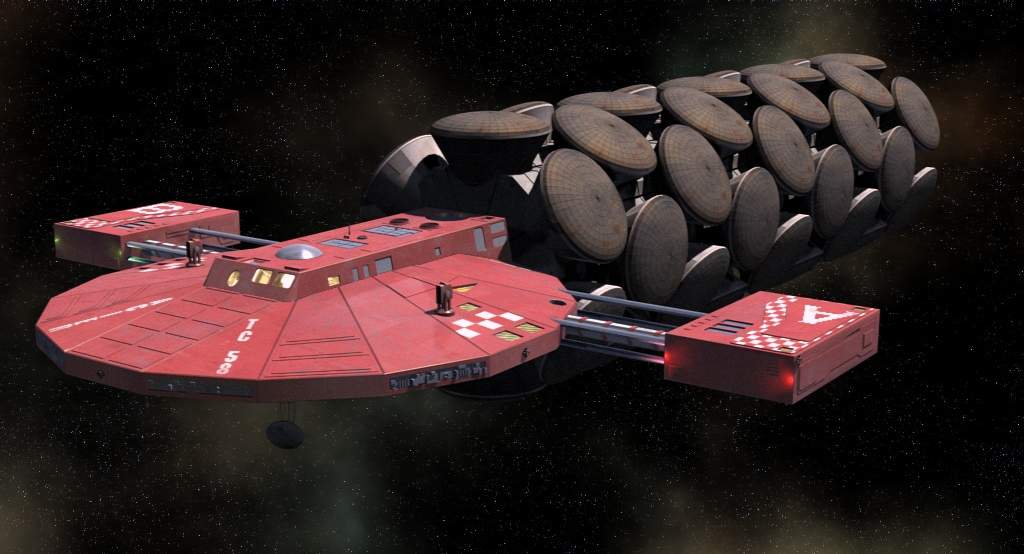
|
Above: The Atalante in transit to Kimanjano from Queen Alice's Star loaded with drop capsules containing the frontline AFV strength of the 2e Division de Marche Coloniale. The drop of this equipment would be one of the turning points of the Liberation of Kimanjano.
The
Metal is a design which is now over eighty years old and long superseded
by more modern types of craft. The Metal was built to move massive amounts
of raw material from France’s colonies to earth to feed the voracious
French economy. The design was a relatively simple one with a forward
module containing the crew, drives and flight systems and a spindle
to which many cargo containers could be attached. At
the outbreak of the Kafer War there were few Metals in service, although
the French government still operated three of the designs. When the
Invasion of the French Arm occurred these ships were pressed into service
moving large consignments of military equipment and supplies. One of
these three was caught and destroyed attempting to reach Beowulf following
the fall of Beta Canum. The other two were at Beowulf and were trained
and equipped to be a key part of the operations of the Armée de Libération.
The
usual cargo modules of the Metal were replaced by dead drop capsules
packed with armoured fighting vehicles and supplies. A single Metal
could carry all the fighting equipment of a French Division de Marche and drop it onto a landing zone in minutes, although
for safety and logistics reasons the troops would have to meet their
equipment on the ground. The
two surviving Metals performed this role to perfection during the Liberation
of Kimanjano where the Atalante and Pacifica landed
two divisions of fresh armour at a key point in the invasion saving
the landings from disaster. These two Metals continued with similar
operations across the Beta Canum Cluster, usually dropping supplies
and reinforcements to fighting troops far from the lines of communication.
The
techniques used by the Metals were far from new, but had never been
applied on such a scale before. The two Metals are assigned to the MSIF’s
Escadre d’Interface
and are a key asset in the on-going war to expel the Kafer Remnants
from the French Arm. |
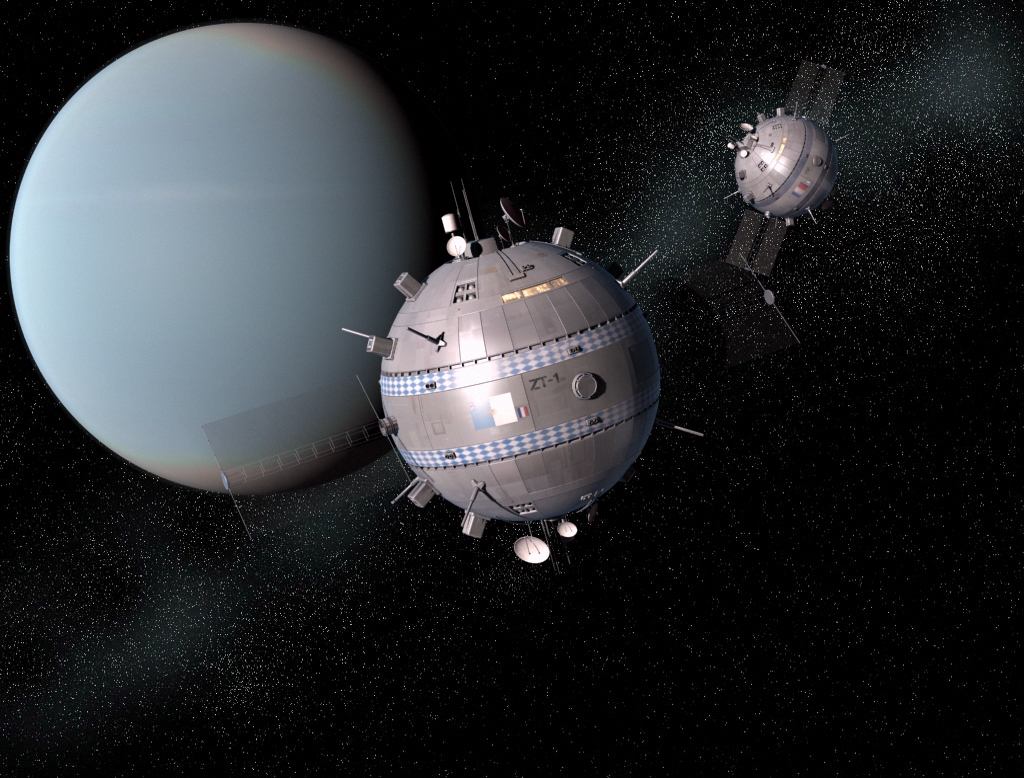
|
Above: The Verteidiger and Moniteur during 2301 trials in the Alpha Centauri system.
The
Moniteur is a joint project being developed
by the Freihafen Raumwaffe with help from
France. The Raumwaffe inherited several warships
from the Bavarian Stern Marine but had only limited resources to build
newer combat ships although it has capacity and expertise to build merchant
ships. France has offered practical support to help the Freihafener’s
efforts to expand her force of warships. The Freihafen designation for
this ship is PSVK-1, but the French term Moniteur
has been adopted by virtually everyone. The
ship is designed to fulfil a system defence role, replacing more expensive
deep space capable warships with cheaper but still powerful vessels.
The Moniteur is a short ranged ship equipped
with a whole range of modern devices and armaments but built largely
to civilian standards. The ship is designed as a purely in-system craft
with only limited ability for interstellar travel and planned to be
based primarily at a high orbital station rather than staying on station
for long durations. The
Moniteur is a very distinctive design, bearing
a passing resemblance to the old British Donovan Class fighter with
its spherical lay out. The ship has had a fairly prolonged gestation
period following its inception after the 3rd Battle of Alpha Centauri,
with the first three ships being completed after 2300. The French have
recently deployed the Moniteur to Beta
Canum on the French Arm to act as a guard ship. The use of the Moniteurs
as enhanced, but still economic, system defence boats has raised the
interest of several nations who have suffered heavy ship casualties
in the Kafer War. The
Moniteurs are heavily armoured and rely on
a combination of MHDs and solar panels for
power, and the stutterwarp drive is currently the same pattern as that
used on the Aconit. Armament includes eight
laser systems and four submunition dispensers
with provision for two missile packs. The ship is very heavily armoured.
|
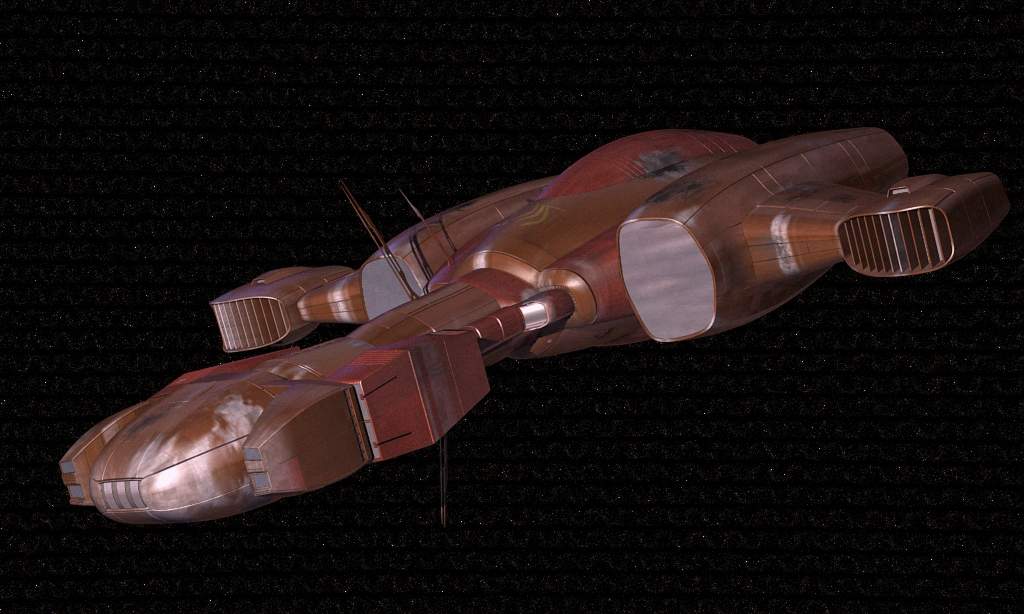
|
Above: An image recovered from the ruins of a Hochbaden orbital habitat in 2303 of a Beta closing to finish the destruction of the habitat. Seconds later the recording finished.
The
Beta Class Battlecrusier was the first class
of Kafer warships encountered by humanity in Eta Bootis and Arcturus.
Indeed it has proved to be one of the more frequently encountered Kafer
ships and no fewer than 15 ships of this type
were involved in Triumphant Destiny’s assault on the Beta Canum
Cluster. The Beta is one of the better understood classes thanks to
the capture of the hulks of two Betas during the fighting at Eta Bootis
in 2298. Human
space naval intelligence agencies believe that the Beta is a class designed
for independent, long duration operations on the borders of Kafer Suzerainties.
This theory states that the larger Alphas and Deltas are reserved for
major combat operations when the Betas will act in a supporting role.
Analysts point to the generally superior combat record of Betas against
human ships which suggests the Betas have more experienced crews and
captains. Betas
are faster than the heavier Battleships but less robust and more lightly
armed, however they are still significant combat platforms. There are
several fugitive Betas still at large in the Beta Canum Cluster and
Eta Bootis Finger and encounters between them and human shipping are
all too common. In
common with most Kafer ships the Beta has no spin habitat and human
analysts are interested in working out how prolonged exposure to Zero-G
effects the efficiency of Kafer crews. |
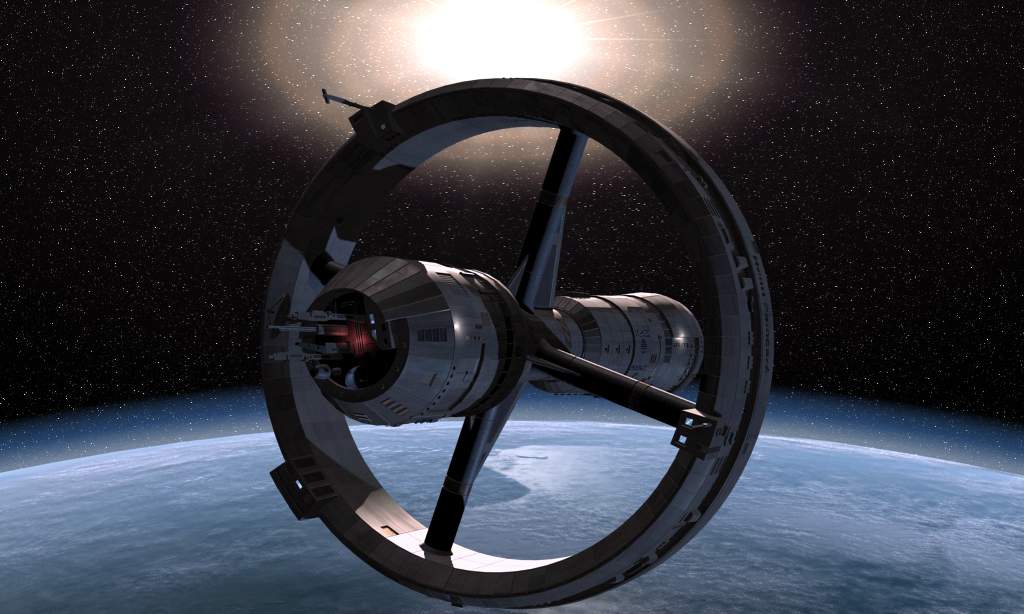
|
Above: The Claude-Louis Berthollet undergoing its armour refit prior to being deployed with the MSIF.
The
Lavoisier Class is the most modern of France’s
fleet of survey vessels, three of these ships were completed during
the 90’s after having been laid down by the junta. The Lavoisiers are modern, comfortable and highly capable ships
which can be tasked with long duration survey missions. The lead ship
the Antoine Lavoisier undertook some
pioneering exploration work in the Wolf Cluster, expeditions which were
curtailed by the outbreak of hostilities with the Kafers. During
the war the Kafers have made excellent use of concealed bases in the
outer edges of remote, and not so remote, systems to support their fleet
operations. Human forces have found these immensely difficult to identify
and destroy. As an interim measure the Claude-Louis Berthollet
was refitted with appliqué armour and submunition
dispensers and dispatched with the Liberation fleets to help in tracking
down the Kafer bases. The Berthollet has been very successful in its operations so far and its exploits have earned it the nickname of the‘limier de Rochemont’. The ship can be found with its escorts along the Eta Bootis Finger and there are rumours that a special Kafer ship akin to the Lone Wolf has been tasked with its destruction.
|
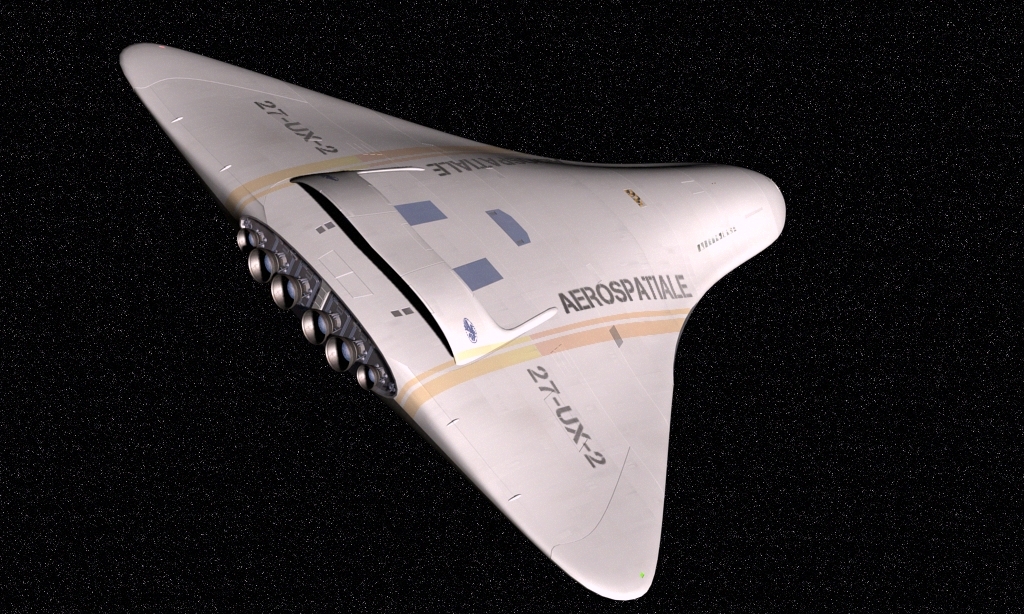
|
Above: The Bayeux closing with its stutterwarp module following the landing of troops on Joi in the spring of 2302.
The
Marseilles Class is a popular and economic class of passenger carrying
liner operating across human space. Modified from an unsuccessful design
for a military troopship, the Marseilles have a unique layout. The ship
has two components, the main body carrying the passengers which is detachable
and interface capability and a stutterwarp and engineering module which
makes the whole ship capable of interstellar travel. Operated
mostly by the French national carrier, Lignes Aérospatiales Françaises,
the ships of the Marseilles Class provided a cheap and efficient travel
service between France’s colonies. However the Kafer War seriously disrupted
this network and some Marseilles were, ironically, taken up by the military
to move troops up to Aurore. With Triumphant Destiny’s offensive
Marseilles were taken up en-masse to supplement France’s MSIF
interface assets and were involved in the evacuation of key personnel
from threatened worlds as well as the movement of troops. The
Marseilles were used as auxiliary ships, moving up large numbers of
troops to the edge of the warzone to marry
up with assault shipping which would then take the soldiers into harm’s
way. The main benefit of the Marseilles was its inbuilt interface capability
which enabled it to uplift an entire battalion of soldiers in a single
movement. Many of the Marseilles have been put back into Lignes Aérospatiales
Françaises service but others remain under military control. All
of the ships in this article are detailed in GDW’s Ships of the French Arm or Invasion Sourcebooks except
the Cayuga and the Moniteur. The Cayuga is
by Clare Hess and more details can be found on the Pentapod’s
World site (http://www.geocities.com/TimesSquare/Arcade/2303/kevin.htm).
The Moniteur is by Laurent Esmiol. All
images are by Laurent Esmiol. Copyright,
2004 Laurent Esmiol and D Hebditch |
